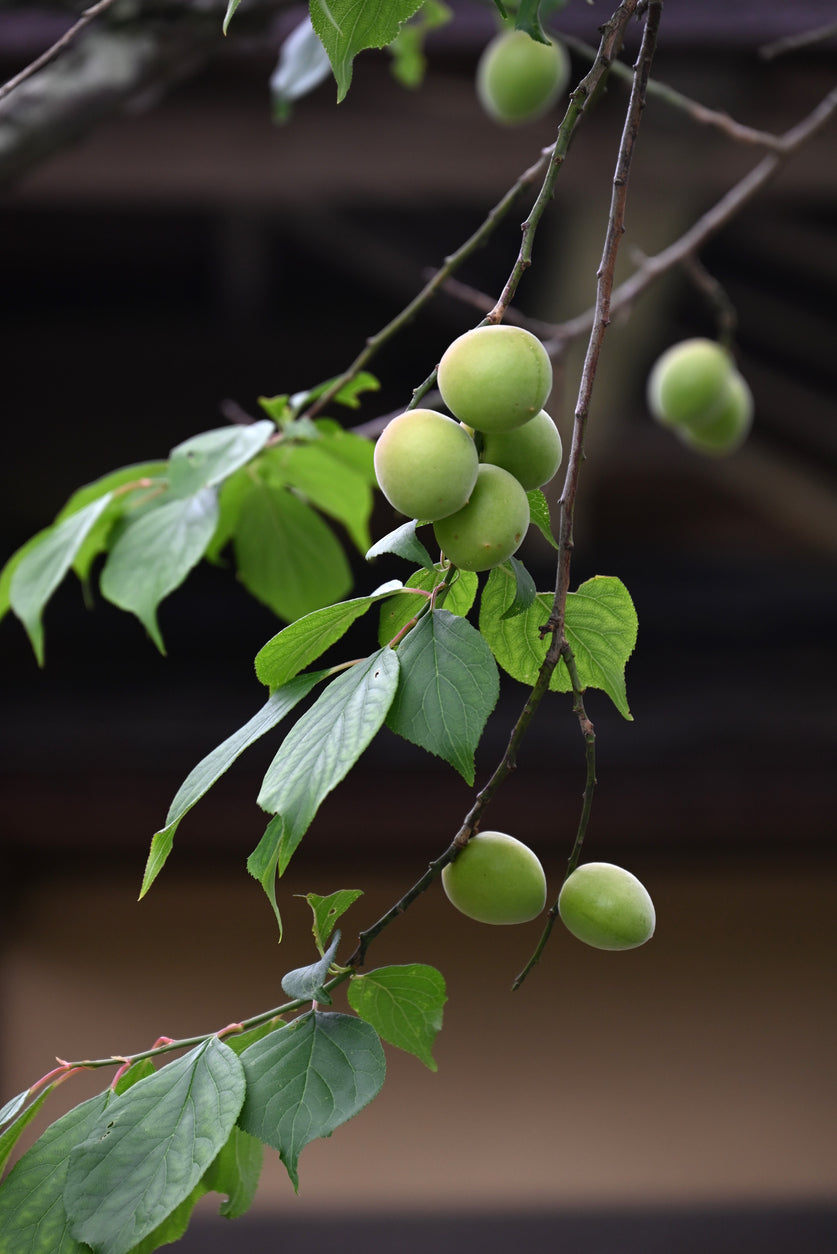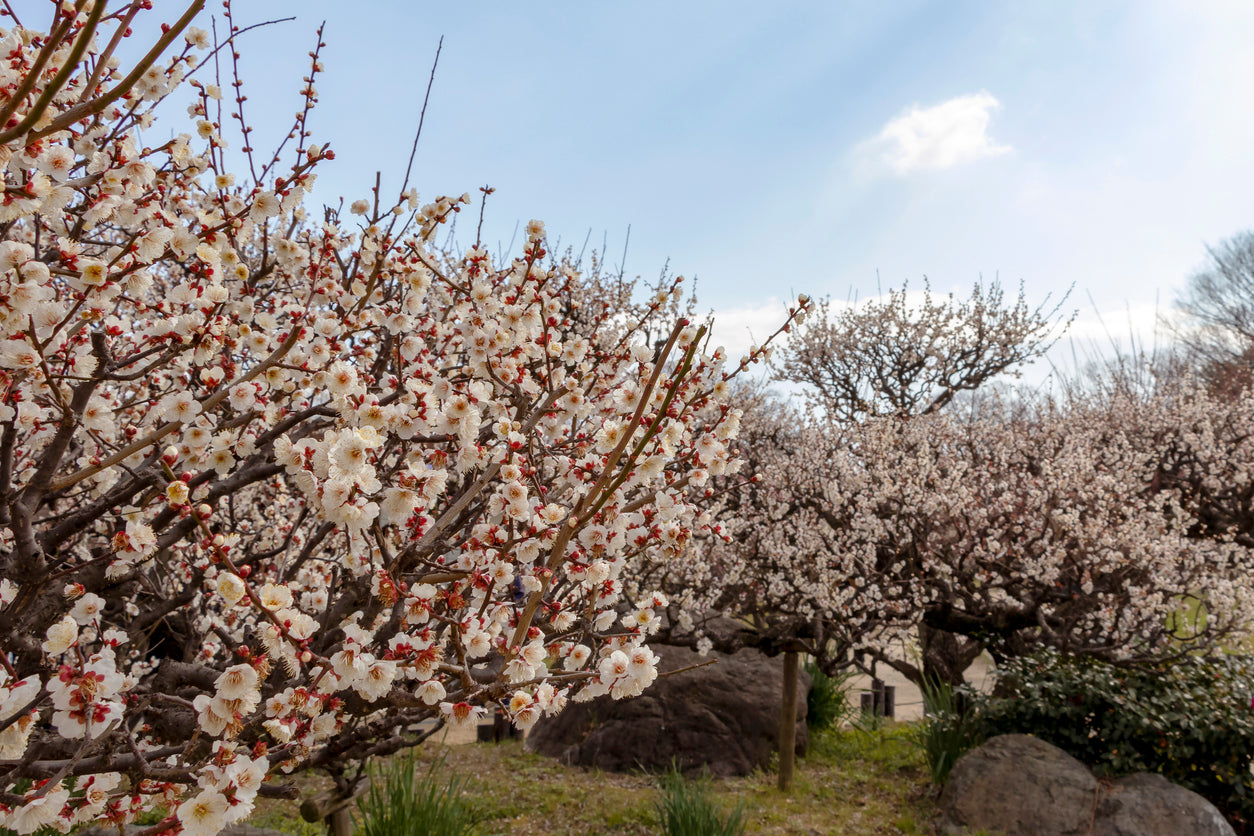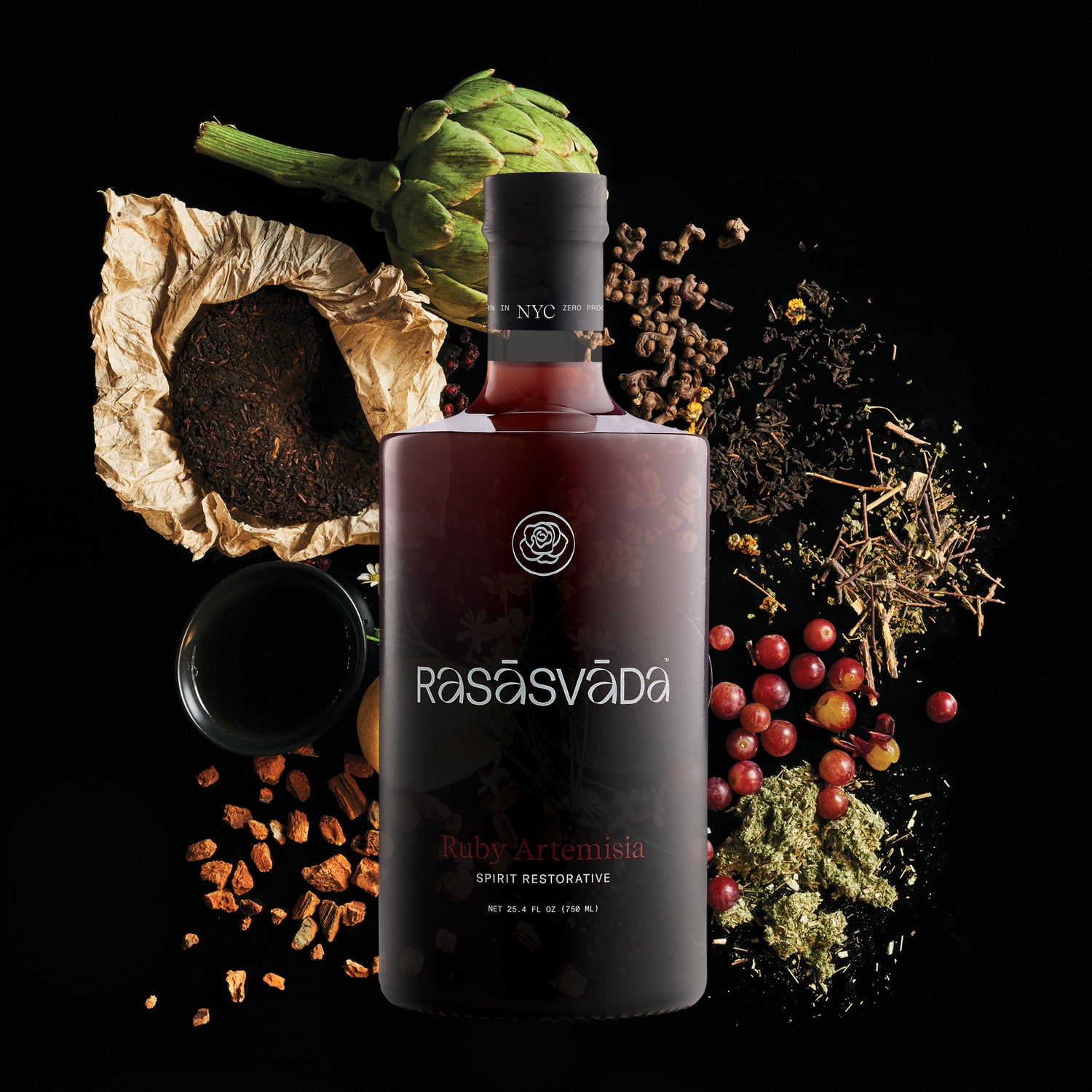Ume plum trees are popular across the globe because of their eye-catching white and pink blossoms that bloom in the early spring. What's lesser known about these widespread trees, though, is that the fruits they bear in the winter— small sour plums which are actually more closely related to apricots than plums — can support your health in a variety of ways and have been cherished in traditional Chinese medicine for over 2000 years.
Ume plum is a key ingredient in Rasāsvāda’s Ruby Artemisia, a zero-additive functional beverage loaded with powerful botanicals. Ume plum adds a bold, tart flavor and contains unique compounds that support overall health.
Read on to learn more about the health benefits of ume plum and its history in East Asian medicine.
Botanical Overview

Botanical Name: Prunus mume
Family: Rosaceae
Common Names: Japanese apricot, Chinese plum
Location/Cultivation: East Asia, including Japan, Korea, and China
History of Ume Plum
Ume plum is a unique tree with a cultivation history that dates back thousands of years. The first wild ume plums were likely enjoyed in ancient China, as far back as 10,000 BC. There is evidence that they were used as a food source and for religious sacrifice. And later, the tree was often planted in imperial and private gardens across China due to its beauty.
While the first wild plums were likely harvested in ancient China, ume plum has also been a staple in Japanese and Korean culture for centuries, both for medicinal and culinary purposes. Ume plums can range from sweet to sour and are unpalatable when consumed raw, so they are processed in methods like smoking, pickling, fermenting, or steeping.
Ume plum syrup is another common way to prepare ume plum. It's made from layering the plums with sugar and sealing the mixture in a jar. Over time, the sugar draws out the ume plum juices.
The syrup is often mixed into beverages or used to make umeshu, a type of Japanese liquor that is slightly sweet and sour. While ume plum is enjoyed for its unique flavor, it's also traditionally used as an elixir for fatigue and seasonal wellness.
Historically, in Traditional Chinese Medicine, ume plum was used to treat cough, stomach issues, and various health conditions.

Health Benefits
Ume plum's use in traditional Chinese medicine is well established, but Western practitioners are just beginning to uncover the potential health benefits of this ancient fruit. Here we’ll discuss the health benefits and the research behind them.
1. Heart health
Blood pressure and cholesterol levels are two indicators of heart health, and ume plum may have a positive effect on both, according to human and animal studies.
While researchers aren’t sure how exactly ume plum helps to lower cholesterol levels, one study found that in people with high cholesterol, supplementation of ume plum helped bring down their LDL or ‘bad’ cholesterol.
When it comes to lowering blood pressure, researchers have more clarity. A study on mice found that ume plum may help stimulate nitric oxide, a compound that helps dilate blood vessels, lowering blood pressure. Scientists think ume plum may support vascular health as well— another important part of overall heart health. But more studies are needed to confirm this function.
2. Anti-inflammatory
While short-term or acute inflammation can be beneficial and help our bodies ward off illness or injury, long-term or chronic inflammation can damage healthy tissue and lead to a whole host of diseases.
The polyphenols (a group of antioxidants) in ume plum may help stave off chronic inflammation that can lead to health conditions. One study found that postmenopausal women who ate dried ume plums saw a reduction in inflammatory markers after 6 months. Researchers will need to conduct more studies to confirm these positive effects and to figure out the most beneficial dose of ume plum, but for now, it’s clear that ume plum has anti-inflammatory potential.
3. Gut health
Your gut is linked with your immune system, metabolism, and even your mood, making gut health an important part of your overall health. Early animal studies show that ume plum may help manage gut inflammation caused by certain health conditions. And even in healthy individuals, ume plum may promote beneficial gut bacteria, which lay the foundation for a balanced digestive tract. Scientists still have to conduct studies to help determine exactly how these benefits can impact humans.
4. Liver health
Researchers think that ume plum may help protect the liver from damage, including damage caused by alcohol. In one study, 200 patients with nonalcoholic fatty liver disease were given ume plum and choline for 24 weeks. At the end of the study, many patients saw a reduction in triglycerides and other markers of liver damage. Some caveats, though: it's unclear how much of these benefits were due to choline versus the ume plum. That said, animal studies have also found ume plum to have beneficial effects on the liver, and scientists have even identified the compounds that are likely responsible for these benefits.
5. Weight management
While scientists are just beginning to study the metabolic effects of ume plums, they believe it may have an impact on metabolism, based on early laboratory studies. According to research findings, ume plum may influence fat storage as well as the body's ability to burn calories and use up energy.
6. Blood sugar support
For people with certain health conditions like PCOS, balanced blood sugar levels can be key to keeping symptoms at bay. Ume plum contains a key compound called munefural, a type of acidic structure that is known to improve insulin sensitivity, helping to lower blood sugar levels.
Ume plums also trigger the secretion of osteocalcin, a compound that most notably helps improve bone density but also plays a role in blood sugar control.
It’s important to note that the studies exploring the link between ume plum and blood sugar have only been conducted in animals so far. In order to make any conclusions on ume plums impact, scientists will need to do research using human subjects.
7. Immune system support
Researchers have found that ume plum has both ‘antiviral’ and ‘antibacterial’ effects. This doesn’t necessarily mean that consuming ume plum can help your body fend off certain viruses or bacteria, but the discovery of antiviral and antibacterial compounds in ume plum may be used to develop new vaccines or medications that can help fend off common viruses or pathogens. This research could be significant, since viruses are constantly evolving and bacteria have the potential to become resistant to common antibiotics.
Ume Plum in Rasāsvāda’s Ruby Artemisia

Ruby Artemisia is a restorative drink featuring time-honored botanicals, like ume plum, fermented green tea, and maqui berry. It's balanced in both flavor and function, so you can savor each sip while supporting your longevity, skin health, metabolic health, and digestion.
Parts used: Fruit, turned into ume plum syrup. Ume plum syrup is made from dried and pickled ume plums when tree-ripe plums sit together with sugar. The sugar draws out the fruit's juices and creates an ultra-concentrated syrup.
Sourced from: Korea
How to drink it: Sip it neat, mix it with sparkling water, or blend it into your daily wellness drink. Ruby Artemisia is naturally caffeinated with Pu’er and Kurikoji green teas, making it perfect for your morning ritual or afternoon pick-me-up. Each serving contains about the same amount of caffeine as a cup of tea.
Key Takeaways
Ume plum is a type of fruit that is native to Japan, Korea, and China, where it has a deep medicinal and culinary history. Historically, in Traditional Chinese Medicine, ume plum was used to treat a variety of health conditions, such as a chronic cough and digestive disorders. In Japan, ume plum is often enjoyed as a wellness tonic. Since raw ume plum is unpalatable and potentially toxic, it is either fermented, pickled, smoked, steeped, or turned into a syrup in order for the health benefits and flavor to be enjoyed. While ume plum has a rich history in East Asia, Western scientists are beginning to research its health benefits, which include its ability to support heart health, liver health, metabolic health, blood sugar, and the immune system. It also contains anti-inflammatory properties.
FAQs
Sources
Frontiers of Pharmacology | Comprehensive Review of Phytochemical Constituents, Pharmacological Properties, and Clinical Applications of Prunus mume
Journal of Food Biochemistry | Therapeutic Potential and Bioactive Compounds of Prunus mume: A Comprehensive Review of Pharmacological Benefits and Future Directions
Bioscience, Biotechnology, and Biochemistry |Traditional Japanese apricot (Prunus mume) induces osteocalcin in osteoblasts
100% plants. 0% preservatives.
